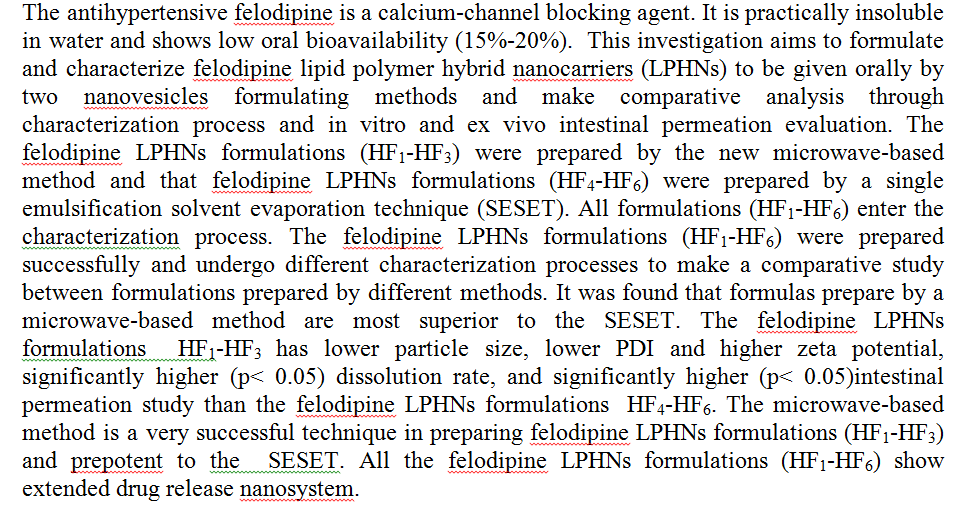 (2)
(2)
 (2)
(2)
Background: The fracture of instruments within root canal during endodontic treatment is a common incidence, fracture because of fatigue through flexure occurs due to metal fatigue, this study aimed to assess the effect of curvature angle and rotational speed on the cyclic fatigue of different type of Endodontic NiTi Rotary Instruments and compare among them. Materials and method: Three types of rotary instruments with tip size 0.25: ProTaPer F2 (Densply, Malifier) Revo-S SU( 0.06 taper, MicroMega) and RaCe system (0.06 taper, FKG, Dentaire), Forty file of each instrument were used within two canals with angle of curvature (40 &60 )at two speed (250&400)RPM, twelve group were formed for all instruments(total number=120),ten file fo
... Show MoreMixed ligand of Co and Ni (II) complexes were prepared from [5-(p-nitrophenyl)-4/-phenyl-1,2,4-triazole-3-dithiocarbamato hydrazide](TRZ.DTC) as primary ligand and 2,2'-bipyridyl (bipy) as a co-ligand with metal salts. These complexes were analytically and spectroscopically characterized in solid state by elemental analyses, flame atomic absorption, magnetic susceptibility and molar conductance measurements, as well as by UV–Vis and FTIR spectroscopy. Infrared, ultra violet spectra reveal a bidentate coordination of the two ligands with metal ions 1:1:1 mole ratio. Room temperature magnetic moments and solid reflectance spectra data indicate paramagnetic complexes with five-coordinate square pyramidal geometry for nickel (II) comple
... Show More- coli K12 and B. subtilis 168 were investigated for their cadmium and mercury tolerance abilities. They were developed by UV mutagenesis technique to increase their tolerances either to cadmium or mercury, and their names then were designated depend on the name and concentration of metals. E. coli K12 Cd3R exhibited bioremediation amount of 6.5 mg Cd/g dry biomass cell. At the same time, its wild-type (E. coli K12 Cd3) was able to remove 5.2 mg Cd/g dry biomass cell in treatment of 17 mg Cd /L within 72 hours of incubation at 37 °C (pH=7) in vitro assays. The results show that E.coli K12 Hg 20 was able to remove 0.050 µg Hg/g dry biomass cell
 (12)
(12)
 (6)
(6)
Polycyclicacetal was prepared from the reaction of PEG with aldehyde derived from Erythro-ascorbic acid (pentulosono-ɣ-lactone-2,3-enedianisoate).All these compounds were characterized by Thin Layer Chromatography (TLC) and FTIR spectra and aldehyde was also characterized by (U.V-Vis), 1HNMR, 13CNMR, and mass spectra.The inhibitory effect of prepared polymer on the activity of human serum AcetylCholinesterase has been studied in vitro. The polymer showed a remarkable activity at low concentration (4.7x10-3 – 4.7x10-8M).
The inelastic C2 form factors and the charge density distribution (CDD) for 58,60,62Ni and 64,66,68Zn nuclei has been investigated by employing the Skyrme-Hartree-Fock method with (Sk35-Skzs*) parametrization. The inelastic C2 form factor is calculated by using the shape of Tassie and Bohr-Mottelson models with appropriate proton and neutron effective charges to account for the core-polarization effects contribution. The comparison of the predicted theoretical values was conducted with the available measured data for C2 and CDD form factors and showed very good agreement.
 (11)
(11)
 (9)
(9)
The purpose of this research is to highlight the relationship between the administrative investigation and the improvement of institutional performance, and the research sought to achieve a set of cognitive and applied goals. the administrative investigation is the modern trend of managing the offices of the general hginspectors and the main source to build the necessary standards to manage and invest its resources efficiently and effectively required to achieve the goals it seeks. The institutional performance is the cornerstone for the implementation of all tasks and duties carried out by institutions operating within the borders of a particular country, The significant change
... Show More (9)
(9)
Blades of gas turbine are usually suffered from high thermal cyclic load which leads to crack initiated and then crack growth and finally failure. The high thermal cyclic load is usually coming from high temperature, high pressure, start-up, shut-down and load change. An experimental and numerical analysis was carried out on the real blade and model of blade to simulate the real condition in gas turbine. The pressure, temperature distribution, stress intensity factor and the thermal stress in model of blade have been investigated numerically using ANSYS V.17 software. The experimental works were carried out using a particular designed and manufactured rig to simulate the real condition that blade suffers from. A new cont
... Show More (2)
(2)
 (13)
(13)
 (13)
(13)

